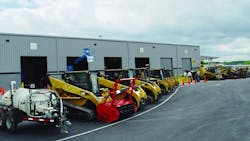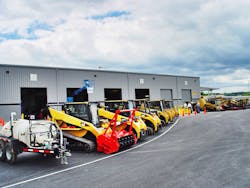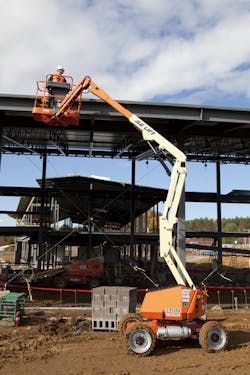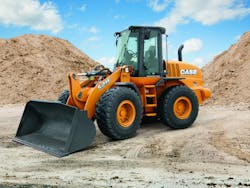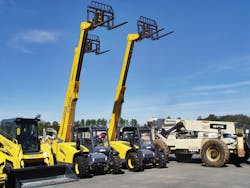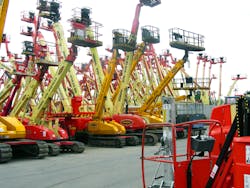Maximizing Profits from Your Rental Fleet
Imagine if you were able to turn the cost and investment structure of your business back 20 years to 1993. Gasoline was $1.16 per gallon. The Dow Jones Index was 3,650. Movie tickets were $4 each. The SUV craze was sweeping America and you could buy a brand new Chevy Blazer or Ford Explorer for about $16,500.
Think about the cost of new equipment. A new, mid-size skid-steer loader (1,700-1,900 pounds) was less than $20,000. An 8,000-pound reach forklift was about $60,000 and, the rule of thumb was that a boomlift cost about $1,000 a foot ($60,000 for a 60-foot boom). According to data I had in my files, representative rental rates on a skid-steer loader were about $1,500 per month; an 8,000-pound, 42-foot reach forklift was about $2,250 per month and, a 60-foot boomlift was about $2,350 per month.
Fast forward 20 years to 2013. That same skid-steer loader costs $25,000-plus, an 8,000 pound reach forklift is around $80,000 and, a 60-foot boom is $85,000 to $90,000. Taking a look at recent rental rates I've seen around the country, 60-foot booms rent at $1,900 to $2,100 a month, mid-sized skid-steer loaders at $1,100 to $1,300 per month and 8,000-pound reach forklifts at $2,100 to $2,300 per month. What's wrong with this picture?
Imagine if, in 1993, someone had come to you and told you virtually every cost of running your business is going to increase anywhere from 30 to 100 percent over the next 20 years but, your rental rates are going to stay the same, or worse, decrease. Would you have stayed in the rental business? How about the opposite? What if a vendor had come to you and said, “I will guarantee you that your current costs will stay the same for the next 20 years?” Would you have taken that proposition? Of course you would have. If you think about it, that's exactly what your rental customers have done with your company.
Much ado has been made recently about rental penetration. In its most simple terms, rental penetration is the percentage of equipment working in the marketplace that is rented versus owned by end-users. The most recent estimates say that rental penetration in the United States is around 50 percent. Common wisdom in the industry is that rental penetration has been much higher in Europe over the years than it has been in the United States. In the Ashtead Group's (parent company of Sunbelt Rentals) 2012 annual report, Ashtead management estimates that rental penetration in the United Kingdom is around 70 percent. In that same annual report, it is estimated by Kaplan Associates that rental penetration in the U.S. was only around 10 percent in 1995.
Industry advocates suggest that the U.S. is headed towards European rental penetration rates and recent increases in rental penetration are because of the great strides that have been made within the U.S. rental industry; i.e. better service, newer equipment, improved uptime, and reliable jobsite delivery. While that may have played a part in the increased rental penetration in the U.S., isn't the more compelling reason for the rental penetration increase due to the fact that rates have essentially not increased in the last 20 years? What if your local gas station was still charging a $1.16 a gallon? What if your local movie theatre was charging $4 a ticket for the most recent Hollywood releases? What type of market share (rental penetration) would these businesses have?
According to Rouse Analytics, financial utilization (formally referred to as dollar utilization), as defined by the ARA Rental Market Metrics system, totaled only 37.7 percent for 2012 for their client reporting companies across all U.S. regions for all categories of equipment. Back in the mid 2000s, many publicly traded companies routinely reported dollar utilization rates from 60 percent to the low 70-percent range. While there may be some discrepancies in the way the reported dollar utilization rates were computed at that time, any way you look at it, it is a big drop from the 70-percent range to 37.7 percent. (Most likely, any discrepancies in reporting only affected the dollar utilization rates by a few percentage points.)
This drop in financial utilization rates is dramatically impacting the financial structure of both publicly traded and privately held rental companies. For example, a $100 million fleet in 2005 would have generated $60 to $70 million in annual rental revenues; the same fleet in 2013 would generate less than $40 million of annual rental revenue. In order to achieve $60-plus million of rental revenue using today's financial utilization rates, a rental fleet of $160 million would be necessary. More investment means more debt and less free cash flow.
To further complicate matters, the rental industry faces rising equipment costs as Tier 4 air quality measures are implemented on new equipment fleets. According to a seminar recently at The Rental Show in Las Vegas, Tier 4 compliance could add anywhere from 5 to 30 percent to the price of new equipment. Unfortunately, smaller equipment that typically has the highest utilization rates is likely to be impacted at the high end of this range; i.e. a $25,000 skid steer may have $5,000 added to the cost (20-percent impact) for Tier 4 compliance, while a $90,000 reach lift may increase by $7,000 or 7.7 percent.
I have always been an advocate of rental companies purchasing late model, used equipment on higher cost, lower utilization type items as a way of increasing financial utilization. Tier 4 implementation will likely drive the price of used machines higher as the demand for the lower priced equipment increases. This can only drive financial utilization rates down from already depressed current levels.
My firm and many acquirers we work with have been placing greater emphasis on the EBITDA generated by a rental company as a percentage of the original cost of its rental fleet. We have found the minimum acceptable percentage for this metric is a ratio of 20 percent EBITDA to the original cost of the rental fleet. In the $100 million rental fleet example above, the minimum acceptable EBITDA would be $20 million, or 20 percent of the original cost of the rental fleet. Looking back at available data from the mid2000s, I can find examples of both privately held and publicly traded rental companies achieving EBITDA percentages in the upper 20-percent to low 30-percent range. Given the recent declines in financial utilization, we see the best run, privately held rental companies in the 20-percent to 25-percent range. Publicly traded companies such as United and Sunbelt have most recently been in the 23-percent to 25-percent range. We have recently run across some privately held rental companies with financial utilization rates under 35 percent that are in the 15-percent to 19-percent range, bringing the overall valuation and marketability of those businesses into question.
What does this mean for you? As I stated earlier, it means more debt and more equipment to generate the revenue and cash flow necessary to run your business. In order to maintain an average fleet age of five years, it’s necessary to reinvest 10 percent of your original equipment cost in new fleet purchases on an annual basis. If you take that 10 percent off the minimum 20 percent EBITDA return we are advocating, that only leaves free cash flow — i.e. your return on investment — of 10 percent. For all the risk a business owner must take in the rental business, a 10-percent return should be the absolute minimum that is acceptable.
Let's walk through some of the math for an independent rental company. If you have a $10 million rental fleet and have a financial utilization of 40 percent, you will generate $4 million in rental revenues. If your company is a top performer, you may generate EBITDA margins of 40 percent of revenue; $4 million in rental revenue would yield $1.6 million in EBITDA. If you reinvest 10 percent of your $10 million rental fleet in new fleet purchases ($1 million) that only leaves $600,000 in free cash flow/return on investment. In other words, on a $10 million investment your return is only $600,000 or 6 percent. Again, for the risk you are taking in running a rental business, 6 percent is not an acceptable return. Many acquirers, potential investors and lenders agree.
So where do we go from here?
The landscape of the rental industry has changed dramatically since the mid-1990s. National companies such as Sunbelt, United, Hertz and Volvo Rents have significantly expanded their geographic footprint. In the Dallas-Fort Worth metropolitan area, I counted a total of 16 RER 100 companies that have one or more locations in the metro area. In addition, there are a handful of local independents, equipment dealers, and specialty rental companies that compete in some form or fashion for the overall rental market. Back in the 1990s, there were three strong local independent rental companies serving the area, as well as a handful of national and regional players. In most markets, there is increased competition for business and that generally means downward pressure on rental rates.
Ten years ago this month (April 2003), I wrote an article in this very magazine entitled, "The 5 Keys to Rate Control," which is still available online at http://rermag.com/mag/5-keys-rate-control. Many of the principles outlined in that article still apply today and it is worth another read. Interestingly enough, I begin the article with the sentence, “Low rental rates are probably the most important issue facing the rental industry today." It appears some things in the rental industry never change.
The two biggest impacts you can have on your financial utilization is the management of your rental rates and management of the composition of your fleet. It is no longer acceptable to review your fleet or your rental rates once a year. The managing of your rental fleet and rental rates requires constant and consistent attention.
In the past, I have seen rental operators make rental rate decisions based on unreliable data from their customers or from their salespeople. This type of unreliable data has caused many rental companies to rent equipment at extremely low rates based on a small sample of data that may not be completely accurate or indicative of the overall market. Having access to and keeping track of current, reliable data from within your trade area is key to correctly adjusting competitive rental rates. New tools such as the ARA Rental Market Metrics and services offered by Rouse Analytics (www.rouseanalytics.com) are now available to rental operators to facilitate accurate tracking and trending reports. Rouse gathers data from all across the country and from all sizes of rental operators, helping you to pinpoint true market rental rates by individual items (50-plus categories and 370-plus individual items) in your area, based upon real market data.
If you are one of 16 rental companies competing for business within a market, or even just one of five or six competing in your local trade area, it can be a difficult and disconcerting process to be a leader by increasing rates within your market. The worry of any rental business owner or manager is to have a yard full of equipment not generating dollars to pay bills. Utilizing industry metrics and benchmarking data such as the Rouse data can help give you, your salespeople and your counter people the confidencethat the rates your company is charging are indicative of market rates. I strongly suggest that your company participate in this type of industry benchmarking and consider utilization of services such as those offered by Rouse Analytics; note that if more data points are available through industry participants, the Rouse benchmarking data will become more beneficial and accurate, likely resulting in a more positive impact on rental rates.
Rouse does report recent positive trends on rental rates with an increase of 17 percent between January 2011 and October 2012. The bad news is that increase only partially offsets the rental rate erosion experienced in the depressed 2008-2010 time frame.
Next to rental rate increases, the most positive impact you can have on your financial utilization rate is to constantly analyze and monitor individual pieces of equipment as well as categories of equipment to maximize your returns. Also in the RER archives, you can find an article I wrote in February 2003 entitled, "Improving Dollar Utilization." This article is also available online at http://rermag.com/mag/improving-dollar-utilizationand outlines some of the basic fundamentals of fleet management.
As an update to that article, my current observations are that many companies (especially larger national companies) have gotten away from lower unit cost items that traditionally have high financial utilization rates. These are items that typically have an individual cost of under $25,000 and include skid-steer loaders, mini excavators, generators, light towers, pumps, air compressors and air tools, and other smaller equipment.
In reviewing my files relating to companies that have the highest EBITDA margins as a percentage of their rental fleet, I have found that these companies have approximately 35 percent of their total fleet value invested in items with an individual cost of $25,000 or less; the same companies have an average financial utilization rate of 86.2 percent on items with an individual cost of less than $25,000. Moving your company to this type of mix can dramatically impact your financial utilization; if you have 65 percent of your fleet generating financial utilization of just 40 percent and, the remaining 35 percent generating 85 percent or better financial utilization, it will improve your overall financial utilization to approximately 55 percent, well above the Rouse average.
Work on translating the good news of increased rental penetration into cash flow for your business by managing your fleet and managing your rental rates. Be a leader in customer service, be a leader in on-time delivery, be a leader in providing high-quality equipment. In return, don't be afraid to have your rental rates reflect the high-quality service and equipment you provide.
Gary Stansberry is president of The Stansberry Firm LLC and specializes in business sales, fair market business valuations, operational consulting and positioning businesses to increase their value. More information on the company can be found at www.thestansberryfirm.com. Gary can be reached at (817) 579-7368 or by email at [email protected].
About the Author
Gary Stansberry
Founder and president
Gary Stansberry is president of The Stansberry Firm LLC and specializes in business sales, fair market business valuations, operational consulting and positioning businesses to increase their value.
